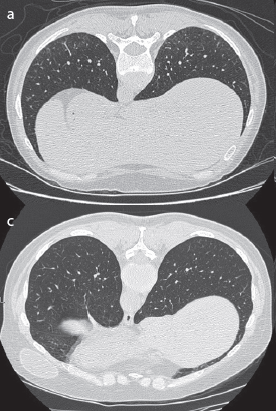Objective: Pulmonary disease is a leading cause of morbidity and mortality in rheumatoid arthritis (RA). In this study, we investigated the prevalence and progression of interstitial lung abnormalities (ILA) in a prospective cohort study of 18 subjects with early RA.
Methods: Eighteen adults diagnosed with anti-citrullinated protein-antibody-positive RA within the prior year underwent baseline high-resolution computed tomography (HRCT), symptom assessment, and pulmonary function and laboratory testing. The follow-up HRCT and clinical assessment were completed after 1 year.
Results: Seven of the 18 patients (39%) had baseline HRCT abnormalities including septal thickening, honeycombing, ground glass opacities, and/or traction bronchiectasis. At follow-up, 6 out of the 7 subjects (86%) with ILAs at baseline exhibited progression, while 10 out of 11 (91%) without ILAs at baseline remained stable. A higher Clinical Chronic Obstructive Pulmonary Disease Questionnaire score was associated with both the presence and progression of HRCT abnormalities (10 vs 2, p=0.045; 10 vs 2, p=0.009, respectively). C-reactive protein (CRP) trended higher in patients with radiologic abnormalities (3.5 mg/L vs 1.1 mg/L, p=0.08) and was significantly higher in those with progression (3.5 mg/L vs 1 mg/L, p=0.024). Smoking, pulmonary function, and autoantibodies were not associated with HRCT abnormalities.
Conclusion: ILAs are prevalent in patients with early RA. If identified at baseline, radiographic progression of ILAs after 1 year is likely, while those without ILAs at baseline are unlikely to develop new ILAs. In addition, early respiratory symptoms and higher CRP levels may correlate with the presence and progression of underlying ILAs.
Cite this article as: Dong H, Julien PJ, Demoruelle MK, Deane KD, Weisman MH. Interstitial lung abnormalities in patients with early rheumatoid arthritis: A pilot study evaluating prevalence and progression. Eur J Rheumatol 2019; 6(4): 193-8.



.png)
